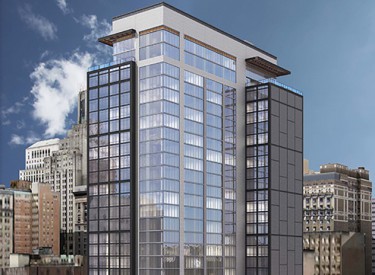By: Matt Hudgins
Philadelphia has an apartment shortage—and big developers are starting to fill the void.
Houston-based property giant Hines is teaming up with the Goldenberg Group, a Philadelphia developer, on a 322-apartment tower planned at 1213 Walnut St. in the hip Midtown Village section of Philadelphia’s Center City neighborhood. Slated for completion in 2017, the $125 million project, which broke ground Dec. 8, is set to rise 26 stories above a bustling streetscape of restaurants, pubs and other businesses.
The project marks Hines’s first foray into Philadelphia and the first venture between the developers and ASB Real Estate Investments, an investment manager in Washington, D.C. The partners say they are pursuing a rare opportunity to build modern multifamily housing in a market where apartment construction still lags behind rapidly growing demand.
The Walnut Street project shows how the urbanism trend can create opportunities in cities that lack a big apartment supply.
“We’re catering to a trend that we’re seeing nationwide, but even more so in Philadelphia,” said Seth Shapiro, Goldenberg’s chief operating officer, referring to the migration of millennials, empty nesters and others to dense urban environments. Philadelphia is behind the curve in providing downtown rental apartments, he said.
Downtown populations are booming, particularly in U.S. cities with five million or more residents, according to the Census Bureau. From 2000 to 2012, population growth averaged 13.3% within a two-mile radius of the city hall in metro areas with five million or more residents, or more than double the metrowide growth rate of 6.2% in those markets, according to the U.S. Census Bureau.
Philadelphia has seen a similar pattern. About 183,000 people now call the Center City neighborhood home, up 16% from 2000.
“Much of this growth is driven by millennials, who have shown a strong preference for not just city living over suburban living, but renting over owning,” said Kevin Gillen, chief economist at consultancy Meyers Research LLC. “Philadelphia is now the No. 1 destination for expat 20-somethings from Brooklyn,” he said, referring to young residents leaving the New York City borough.
Yet apartments make up just 15% of the housing stock across Philadelphia, a far smaller share than in other markets with strong urban cores, according to data from the National Multifamily Housing Council. By contrast, apartments account for 30% of housing in Chicago, 35% in Boston and 51% in New York City, according to the NMHC.
As a result, apartment rents are skyrocketing. The average rent for a one-bedroom apartment in Center City is now $1,650 a month, up 40% from $1,175 in 2010, Mr. Gillen said.
Those rent gains spurred record construction last year, with permits issued to build 2,750 multifamily units, topping the record of 2,555 set in 2004 and raising fears of overbuilding. Now developers are taking a pause. The number of building permits issued for new units in Philadelphia in 2015 is poised to decline for the first time since 2009.
Slight fluctuations in supply shouldn’t hinder 1213 Walnut’s performance if lease rates remain unchanged, according to Mr. Shapiro. “The market rents for Class A product today fully support our underwriting and our construction costs,” Mr. Shapiro said. He declined to specify rents for the project. Current rent for Class A apartments in Center City average $2,265 per unit, according to research firm Reis.
Daniel Moore, Hines’ managing director in its Washington, D.C., office, is confident 1213 Walnut’s high-end finishes and efficient design will attract residents. Many of the new apartments in Center City are in former office buildings converted for residential use, he said. Building a new structure lets his team cater the entire project to modern tastes and needs, providing a competitive edge for marketing the space.
For example, a package room with refrigerated space will enable an attendant to hold goods and groceries delivered to residents in their absence. The residential units eliminate corridors and wasted space while maximizing windows with broad floor plans, he said.
“We have the benefit of doing this from the ground up so we have a blank slate, as opposed to so many of the projects that have historically been in Philadelphia,” he said.
http://www.wsj.com/articles/philadelphia-apartment-market-expands-1450175400
